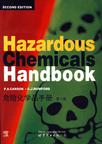危险化学品手册
2005-4
世界图书出版公司
Phillip Carson;C J MUMFORD
608
It is hoped that this book will prove valuable to safety advisers, environmental health officers,emergency services personnel, safety representatives and those engaged in the transport or disposal of wastes-in fact, to anyone involved with chemicals ' in the field', i.e. away from ready access to chemical safety data sheets, detailed texts, library facilities or computerized databanks. It also provides a useful summary for those who may need to make only passing reference to the hazardous properties and potential effects of chemicals, such as general engineering students and occupational health nurses.
Preface to the second editionPreface to the first edition1 Introduction2 Terminology3 General principles of chemistry Introduction Atoms and molecules Periodic table Valency Chemical bonds Oxidation/Reduction Physical state Acids Bases Halogens Metals Oxygen and sulphur Nitrogen, phosphorus, arsenic and antimony pH Salts Organic chemistry Combustion chemistry Chemical reactivity4 Physicochemistry Vapour pressure Gas-liquid solubility Liquid-to-vapour phase change Solid-to-liquid phase change Density differences of gases and vapours Density differences of liquids Immiscible liquid-liquid systems Vapour flashing Effects of particle or droplet size Surface area effects in mass transfer or heterogeneous reactions Enthalpy changes on mixing of liquids Critical temperatures of gases Chemical reaction kinetics Corrosion Force and pressure Expansion and contraction of solids5 Toxic chemicals Introduction Hazard recognition Types of toxic chemicals Hazard assessment Risk assessment of carcinogens Risk control Control of substances hazardous to health Specific precautions6 Flammable chemicals Ignition .and propagation of a flame front Control measures Fire extinguishment Fire precautions7 Reactive chemicals Water-sensitive chemicals Toxic hazards from mixtures Reactive hazards from mixtures Oxidizing agents Explosive chemicals General principles for storage Hazards arising in chemicals processing8 Cryogens Liquid oxygen Liquid nitrogen and argon Liquid carbon dioxide Liquefied natural gas9 Compressed gases Acetylene Air Ammonia Carbon dioxide Carbon monoxide Chlorine Hydrogen Hydrogen chloride ……10 Monitoring techniques11 Radioactive chemicals12 Safety by design13 Operating procedures14 Marking 15 Transport of chemicals16 Chemicals and the environment:sources and impact17 Chemicals and the environmnt:monitoring and protection18 Conversion tables and measurement data19 BibliographyAppendix:Selected UK legislation relevant to enviromental protection and occupational health and safety in relation to chemicalsIndex
